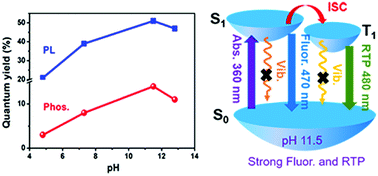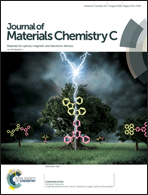High pH-induced efficient room-temperature phosphorescence from carbon dots in hydrogen-bonded matrices†
Abstract
Carbon dots (CDs) have been promising candidates for metal-free room temperature phosphorescence (RTP) materials recently, but they generally exhibit extremely dim phosphorescence, mainly due to the lack of design guidelines. Herein, we present a new RTP emission enhancing strategy that induces the deprotonation of carboxyl groups on the surfaces of CDs by adjusting the pH to increase the degree of conjugation between the carboxyl group and the carbon core and decrease the surface defect. In addition, for the matrices, the C–O−⋯H hydrogen-bonding systems in cyanurate have stronger hydrogen-bonded networks than the C![[double bond, length as m-dash]](https://www.rsc.org/images/entities/char_e001.gif) O⋯H hydrogen-bonding systems in cyanuric acid, minimizing nonradiative transitions of triplet excitons. Notably, their phosphorescence quantum yield (14%) at high pH is nearly 5 times higher than that of CD-based composites under acidic conditions. Furthermore, chemical sensors and light-emitting diodes based on CD-based composites are realized by taking advantage of their efficient dual emission feature.
O⋯H hydrogen-bonding systems in cyanuric acid, minimizing nonradiative transitions of triplet excitons. Notably, their phosphorescence quantum yield (14%) at high pH is nearly 5 times higher than that of CD-based composites under acidic conditions. Furthermore, chemical sensors and light-emitting diodes based on CD-based composites are realized by taking advantage of their efficient dual emission feature.



 Please wait while we load your content...
Please wait while we load your content...